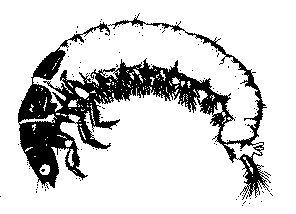For a more advanced version of this activity see the WatershED Learning
Activity Assessing Your Waterway: Macroinvertebrates-Long
Term Ecosystem Health
 A terrific
field activity for fifth graders, the following can be done in even
the smallest of flowing streams or irrigation ditches.
A terrific
field activity for fifth graders, the following can be done in even
the smallest of flowing streams or irrigation ditches.
Collecting macroinvertebrates from a stream is a fun and motivating
activity for upper elementary school students. The quantity, types,
and diversity of the "bugs" collected can reveal a lot about
the health of a stream. Students will be surprised and amazed by the
whole new world of life they uncover in this activity.
Samples can be collected in a variety of ways. A common technique is
to place the net in the stream and then use a stick, your feet, or hands
to stir gravel up-stream from the net. Macroinvertebrates will be dislodged
and washed into the net. Empty the net into the specimen jar. For illustrations
of this so-called "kicking and picking" see the following
sites:
http://www.people.Virginia.EDU/~sos-iwla/Stream-Study/Methods/Procedures.HTML
http://www.epa.gov/OWOW/monitoring/volunteer/stream/66.html
 Another method
is simply to collect a few submerged rocks, place them in a bucket and
return to analyze the substrate back in the classroom. The bottom of
the rocks can be scrubbed with a soft dishwashing brush to dislodge
macroinvertebrates.
Another method
is simply to collect a few submerged rocks, place them in a bucket and
return to analyze the substrate back in the classroom. The bottom of
the rocks can be scrubbed with a soft dishwashing brush to dislodge
macroinvertebrates.
Classroom analysis: Specimens can be classified using a variety of
taxonomy guides. See the Izaak Walton League guide http://www.people.Virginia.EDU/~sos-iwla/Stream
Study/StreamStudyHomePage/StreamStudy.HTML, which divides commonly
found invertebrates into 3 classifications, depending upon the type
of water quality they can tolerate.
 For example:
mayfly larvae are generally found in good quality water. Leeches may
be found in all ranges of water quality, but you would not expect to
find mayflies in water that has been severely polluted.
For example:
mayfly larvae are generally found in good quality water. Leeches may
be found in all ranges of water quality, but you would not expect to
find mayflies in water that has been severely polluted.
Have the students work in groups of 2-3 for classifying the bugs. They
should also check for diversity of bugs. Have each group write up a
summary of their results, evaluating what type of water quality they
think exists, the diversity of organisms, etc.
Classifying water quality based on macroinvertebrates found is simply
one more tool to complete the picture regarding the health of your stream.
The following part of the activity might involve math that is
too complex for some elementary school students. Calculators can facilitate
the SCI computation.
Measuring Diversity: The Sequential Comparison
Index
The diversity of organisms is also a potential indicator of stream
quality. A simple diversity index, called the Sequential Comparison
Index (SCI) can be performed by placing a random sample of invertebrates
in a tray and counting the different organisms. Each time a different
type of organism is encountered, the student will record this as the
start of a new "run."
SCI = # of runs ÷ total # of organisms
The SCI runs from 0 to 1.0, with 1.0 representing the greatest diversity.
You can use the SCI to evaluate water quality.
SCI Water Quality
0 - 0.30 poor
0.31 - 0.60 fair
0.61 - 1.0 good
For example: You have collected 15 bugs. You identify a sequence of
5 mayflies (first run), and then find a leach (second run), then 4 mayflies,
two scuds, a gilled snail, and then 2 more mayflies. Your number of
runs is 6.
6 ÷ 15 = 0.40
The water quality is fair!!
The advantage of the SCI is you don't have to accurately identify all
of the organisms, just whether or not they are different.
For a thorough and detailed description about doing stream macroinvertebrate
survey, see http://www.epa.gov/OWOW/monitoring/volunteer/stream/vms42.html
This site includes illustrations of collecting samples in nets by
"kicking and picking," as well as other information.
Reference
Pobst, Dick. Trout Stream Insects. 1990
.
Izaak Walton League. Save Our Streams Taxonomy Chart.
Ward, J.V. and B.C. Kondratieff. An Illustrated Guide
to the Mountain Stream Insects of Colorado. 1992.
VIRTUAL MACROINVERTEBRATE STUDY
I would never recommend the following activity as a substitute for
the field study of macroinvertebrates! However, if you have no access
to a stream or irrigration ditch or if you need an idea for an
activity which involves students using the internet, try the virtual
macroinvertebrate activity at this site:
http://www.people.Virginia.EDU/~sos-iwla/Stream-Study/Samples/SampleIntro.HTML
Return to BASIN Learning
Return to Fifth Grade Unit

